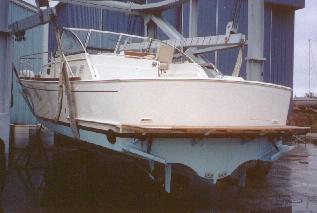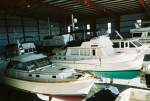When you take away days you have to work, days when it’s raining, days when the temperatures are too hot or too cold, days you have to attend weddings, funerals, birthday parties, family vacations, business meetings, days when you’re a bit under the weather, and that big block of time known as winter – what you have left is the boating season. And as the boating season begins its gradual fading into a distant memory, your attention turns to winterizing.

Some customers leave the whole job to the boat yard’s capable hands. Which is fine unless you are the kind of person who likes to be involved with your boat’s upkeep or to shave a few dollars off the ever-increasing cost of maintaining a boat. Even if you don’t fit into either of these categories, you may just want to know what’s involved in the whole process.
One thing to keep in mind is that each thing that you put off until spring has an exponential chance of delaying the start of your boating season as spring is the busiest time of year for the boatyard. We provide a check list for each boat listing everything that should be done and a section to note problems which should be taken care of during lay-up.
Exterior

The best protection for the exterior of your boat is to store it inside. This protects the boat against harmful UV rays, winds, snow, rain and extreme temperature changes, all of which affect gelcoat, varnish, and gear. If this is not possible a cover should be installed that will cover the deck area. Loose gear and canvas should be removed. If hull sides are exposed, the gelcoat should be waxed to protect it during layup.The bottom should be well cleaned – any marine growth is easier to remove when fresh. After the bottom is clean you should inspect carefully for blistering. Note that evident blisters start to recede after the boat sits, so you should inspect as soon as possible after hauling and mark isolated blisters for later repair. If the problem is severe you should seek professional advice. You should also check props for signs of damage, cutlass bearings for sign of wear, and underwater hardware for adhesion integrity.
Interior
All food and drink should be removed from the boat – especially items in bottles and jars which could freeze and burst. This would be a good chance to take home dinnerware and cookery to run through the dishwasher. Leave icebox doors, cabinet doors, and compartment doors ajar. Remove batteries from handheld equipment. This would also be a good time to check expiration dates on flares and check charts for print dates. Note also the last inspection date on fire equipment.
Water systems
The best way to totally winterize the water system is to remove the feed hose from the water tank and insert it straight into a bucket of non-toxic antifreeze. Turn on the house water pump and go to each faucet and shower head and run the spigot until antifreeze comes out. Check out the best house cleaning business software at
https://www.maidcentral.com/ site. This will also leave antifreeze in the hoses. Don’t forget other water systems such as icemakers, windshield wipers, etc. Holding tanks should be pumped before winterizing and antifreeze should, again, be introduced through the intake hose to fill the pumps as well as the bowl.
Engine
Engine winterizing is more involved than flushing with antifreeze. This is the time when fluids should be changed (ie: oil and transmission) and a total survey done of the condition of the engine, belts, systems, hoses, etc. Many customers winterize much of the boat but leave this to the yard because it is easier for a trained mechanic to spot potential problems. This is more than grunt work.Some yards advocate removing the batteries, but if you plan on being on the boat during the winter for inspections or a bit of work, it’s real nice having some lights on boat. Plus, if the boat is left outside, it is absolutely necessary to have bilge pumps working. We have opened a boat in the spring to find water over the floorboards.
Also to consider
When we winterize the boat, we also take other factors in consideration. It is important to keep the bilges dry. It makes no sense to pull the boat to let it dry but leave water in the bilges. So we remove all the water from the bilges when we winterize. And as long as you are doing that, it makes sense to clean the bilges at the same time. And since you have to remove the grates to get to the bilges, you might as well clean them as well. It just makes good sense to get this done once a year.
 Some customers leave the whole job to the boat yard’s capable hands. Which is fine unless you are the kind of person who likes to be involved with your boat’s upkeep or to shave a few dollars off the ever-increasing cost of maintaining a boat. Even if you don’t fit into either of these categories, you may just want to know what’s involved in the whole process.
One thing to keep in mind is that each thing that you put off until spring has an exponential chance of delaying the start of your boating season as spring is the busiest time of year for the boatyard. We provide a check list for each boat listing everything that should be done and a section to note problems which should be taken care of during lay-up.
Some customers leave the whole job to the boat yard’s capable hands. Which is fine unless you are the kind of person who likes to be involved with your boat’s upkeep or to shave a few dollars off the ever-increasing cost of maintaining a boat. Even if you don’t fit into either of these categories, you may just want to know what’s involved in the whole process.
One thing to keep in mind is that each thing that you put off until spring has an exponential chance of delaying the start of your boating season as spring is the busiest time of year for the boatyard. We provide a check list for each boat listing everything that should be done and a section to note problems which should be taken care of during lay-up.
 The best protection for the exterior of your boat is to store it inside. This protects the boat against harmful UV rays, winds, snow, rain and extreme temperature changes, all of which affect gelcoat, varnish, and gear. If this is not possible a cover should be installed that will cover the deck area. Loose gear and canvas should be removed. If hull sides are exposed, the gelcoat should be waxed to protect it during layup.The bottom should be well cleaned – any marine growth is easier to remove when fresh. After the bottom is clean you should inspect carefully for blistering. Note that evident blisters start to recede after the boat sits, so you should inspect as soon as possible after hauling and mark isolated blisters for later repair. If the problem is severe you should seek professional advice. You should also check props for signs of damage, cutlass bearings for sign of wear, and underwater hardware for adhesion integrity.
The best protection for the exterior of your boat is to store it inside. This protects the boat against harmful UV rays, winds, snow, rain and extreme temperature changes, all of which affect gelcoat, varnish, and gear. If this is not possible a cover should be installed that will cover the deck area. Loose gear and canvas should be removed. If hull sides are exposed, the gelcoat should be waxed to protect it during layup.The bottom should be well cleaned – any marine growth is easier to remove when fresh. After the bottom is clean you should inspect carefully for blistering. Note that evident blisters start to recede after the boat sits, so you should inspect as soon as possible after hauling and mark isolated blisters for later repair. If the problem is severe you should seek professional advice. You should also check props for signs of damage, cutlass bearings for sign of wear, and underwater hardware for adhesion integrity.

